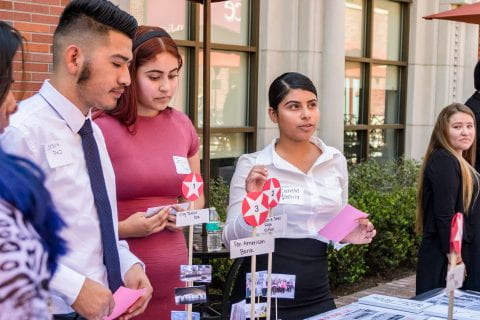“Greetings from East L.A.” reviews the region’s various modes of transportation, with help from high school students representing the East Los Angeles Renaissance Academy (ELARA) at Esteban Torres High School.
The third-year partnership involves the academy, the USC Price School of Public Policy and the social enterprise nonprofit Public Matters, with partial funding from USC’s Learning to Excel Academically and Professionallyprogram.
The students set up models in USC Price’s Franklin Garden Plaza and presented maps highlighting East L.A.’s rich culture, taking onlookers on a tour of several landmarks and pointing out the modes of transportation they used to get from place to place.

Professor David Sloane, left, discusses a neighborhood model made by ELARA high school students. (Photo/Deirdre Flanagan)
“I was really impressed by the conceptual strength of the tours,” said USC Price Professor David Sloane, the faculty member who leads the collaboration. “They are very coherent, pick up essential elements of East L.A. history and do it in a way that makes sense.”
Three USC Price first-year Master of Planning (MPL) students and one undergraduate student provided lessons and advice to the ELARA students through internships with Public Matters. ELARA is one of three high school programs in the nation that focuses on urban planning and design.
“I have a lot of passion in community engagement and youth empowerment, so I felt like the design of this program fit that perfectly,” said MPL student Kristian Castro. “I’m very interested in placemaking and this idea of how communities themselves can drive the vision of what they want to see. Especially working with high schoolers, these are going to be the future generations of our cities, so I enjoyed helping them learn these concepts so they can mobilize change.”
Urban planning lessons: Tools for success
USC Price students helped provide the 11th grade class with tools to do the asset-mapping project by leading class sessions in an introduction, history and future of transportation, as well as how to use Google maps.

The partnership connected USC Price students from varied backgrounds with local high school students. (Photo/Deirdre Flanagan)
“It was my first time teaching a class of high school students,” said MPL student Tanya Shah. “They were passionate about the points and tours they were choosing, and we made it easier for them to understand how to work on their visualizations,” she said. “As an international student, this was a good way to learn about different parts of Los Angeles from people living there.”
For MPL student Daniel Coronado, getting the internship was a personal experience because he grew up in East L.A.
“I felt this was the perfect way to give back to my community,” Coronado said. “I didn’t learn about planning until my third year of undergrad, so I think exposing planning to the younger generations — especially people of color — is very important within the planning profession.”
Questions, anyone? The teens had answers
In addition to designing and setting up the mapping tours, ELARA students stood near their projects to answer questions from USC students, faculty and staff about the value they assign to the places they chose for their tours and their perspectives on transportation options in the community. The week after their presentations in early April, the ELARA students made the same presentations at the Los Angeles County Department of Public Works.

Students from the East Los Angeles Renaissance Academy get a taste of the planning profession. (USC Photo/Deirdre Flanagan)
“I hope everybody who came here learned more about East Los Angeles and how unique it is, how these places are a staple of our community and our culture, and how we are different from every other community,” said ELARA student Jose Hernandez. “Working with USC Price and Public Matters has shown us that we have a choice in what happens in our community, and that other people care about what happens in our community.”
John Sonego, associate dean for development and external relations at USC Price, introduced Christine Vasquez, the first ELARA student accepted to USC. Although she hasn’t been in the class that participated in the “Greetings” program, Vasquez noted that she had heard a lot about it from schoolmates. While she hasn’t made a final decision of where she will attend college, Vasquez, who wore a USC T-shirt, said she was excited about the possibility of majoring in urban planning and public policy at USC Price.
“I think the big thing is that she could imagine that she could come here,” Sloane said. “That’s the culture change, the shift we need to have. People who see USC as this kind of unimaginable place for them to attend see that broken down by programs like this.”
Exploring travel habits
The USC Price students who interned for Public Matters also conducted a poll on the transit habits and perspectives of the ELARA students, who kept a transit diary for a period of about one month. Responding to their preferred mode of transit, 43.8 percent said car, 40.6 percent walking and 15.6 percent bus. Only 9.4 percent said they would use a bike-share program that is currently under consideration in the area.
“What the data show us is that walking or taking a car is still the most dominant mode of transportation for students — which was really surprising because many students thought more of them took the bus than they actually did,” said Lilly Nie, a USC Price student who presented the results of the study. “There’s a tradition of unilaterally doing things sometimes in planning, and what we’re doing here is trying to engage students directly in the process and have them be a part of the conversation when they really didn’t know they could before.”
More stories about: Community Outreach, Diversity, Students, Urban Planning
